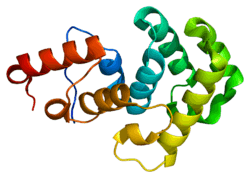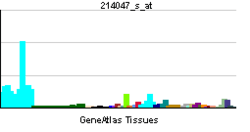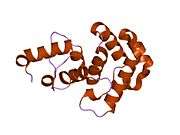MBD4
| View/Edit Human | View/Edit Mouse |
Methyl-CpG-binding domain protein 4 is a protein that in humans is encoded by the MBD4 gene.[3][4][5]
Structure
Human MBD4 protein has 580 amino acids with a methyl-CpG-binding domain at amino acids 82–147 and a C-terminal DNA glycosylase domain at amino acids 426–580.[6] These domains are separated by an intervening region that interacts with UHRF1, an E3 ubiquitin ligase, and USP7, a de-ubiquinating enzyme.[7]
Function
DNA methylation is the major modification of eukaryotic genomes and plays an essential role in mammalian development. Human proteins MECP2, MBD1, MBD2, MBD3, and MBD4 (this gene) comprise a family of nuclear proteins related by the presence in each of a methyl-CpG-binding domain (MBD). Each of these proteins, with the exception of MBD3, is capable of binding specifically to methylated DNA. MBD4 may function to mediate the biological consequences of the methylation signal. In addition, MBD4 has protein sequence similarity to bacterial DNA repair enzymes and thus may have some function in DNA repair. Further, MBD4 gene mutations are detected in tumors with primary microsatellite instability (MSI), a form of genomic instability associated with defective DNA mismatch repair, and MBD4 gene meets 4 of 5 criteria of a bona fide MIS target gene.[5]
Deaminated bases as targets

Bases in DNA decay spontaneously, and this decay includes hydrolytic deamination of purines and pyrimidines that contain an exocyclic amino group (see image). Hypoxanthine and xanthine are generated at a relatively slow rate by deamination of adenine and guanine, respectively. However, deamination of pyrimidines occurs at a 50-fold higher rate of approximately 200–300 events per cell per day,[6] and is potentially highly mutagenic. Deamination of cytosine (C) to uracil (U) and 5-methylcytosine (5mC) to thymine (T) generates G:U and G:T mismatches, respectively. Upon DNA replication, these mismatches cause C to T transition mutations. Notably, for 5mC deamination, these mutations arise predominantly in the context of CpG sites. The deamination rate of 5mC is approximately three times that of C. MBD4 protein binds preferentially to fully methylated CpG sites and to their deamination derivatives G:U and G:T base pairs.[6] MBD4, which is employed in an initial step of base excision repair, specifically catalyzes the removal of T and U paired with guanine (G) within CpG sites.[8]
Mutational importance of targets
G:U and G:T mismatches, upon DNA replication, give rise to C to T transition mutations.[8] The mismatched U or T is usually removed by MBD4 before replication, thus avoiding mutation. Alternatively, for G:T mismatches, the T may be removed by thymine-DNA glycosylase. Mutations in the MBD4 gene (especially expansions/deletions in the polyadenine regions of the MBD4 gene) increase the genomic instability phenotype of a subset of MMR-defective tumors in mice, specifically contributing to elevated G:C to A:T transitions.[9]
About 1/3 of all intragenic single base pair mutations in human cancers occur in CpG dinucleotides and are the result of C to T or G to A transitions.[8][10] These transitions comprise the most frequent mutations in human cancer. For example, nearly 50% of somatic mutations of the tumor suppressor gene p53 in colorectal cancer are G:C to A:T transitions within CpG sites.[8]
Clinical significance
Epigenetic silencing in cancer
MBD4 mRNA expression is reduced in colorectal neoplasms due to methylation of the promoter region of MBD4.[11] A majority of histologically normal fields surrounding the neoplastic growths also show reduced MBD4 mRNA expression (a field defect) compared to histologically normal tissue from individuals who never had a colonic neoplasm. This indicates that an epigenetic deficiency in MBD4 expression is a frequent early event in colorectal tumorigenesis.
While other DNA repair genes, such as MGMT and MLH1, are often evaluated for epigenetic repression in many types of cancer,[12] epigenetic deficiency of MBD4 is usually not evaluated, but might be of importance in such cancers as well.
Mutations in cancer
Mutation of MBD4 occurs in about 4% of colorectal cancers.[9] MBD4 mutations also occur in tumor samples of melanoma, ovarian, lung, esophageal and prostate cancers at frequencies between 0.5% and 8%.[9]
MBD4 has a special relationship with DNA mismatch repair (MMR). MBD4 protein binds strongly to the MMR protein MLH1.[4] A mutational deficiency in MBD4 causes down-regulation, at the protein level, of MMR proteins Mlh1, Msh2, Pms2, and Msh6 by 5.8-, 5.6-, 2.6-, and 2.7-fold, respectively.[13] In colorectal cancers with mutations in MMR genes, co-occurrence of MBD4 mutations were found in 27% of cancers.[9]
Interactions
MBD4 has been shown to interact with MLH1[4] and FADD.[14]
References
- ↑ "Human PubMed Reference:".
- ↑ "Mouse PubMed Reference:".
- ↑ Hendrich B, Bird A (Nov 1998). "Identification and Characterization of a Family of Mammalian Methyl-CpG Binding Proteins". Mol Cell Biol. 18 (11): 6538–47. PMC 109239
 . PMID 9774669.
. PMID 9774669. - 1 2 3 Bellacosa A, Cicchillitti L, Schepis F, Riccio A, Yeung AT, Matsumoto Y, Golemis EA, Genuardi M, Neri G (May 1999). "MED1, a novel human methyl-CpG-binding endonuclease, interacts with DNA mismatch repair protein MLH1". Proc Natl Acad Sci U S A. 96 (7): 3969–74. doi:10.1073/pnas.96.7.3969. PMC 22404
 . PMID 10097147.
. PMID 10097147. - 1 2 "Entrez Gene: MBD4 methyl-CpG binding domain protein 4".
- 1 2 3 Bellacosa A, Drohat AC (Aug 2015). "Role of base excision repair in maintaining the genetic and epigenetic integrity of CpG sites". DNA Repair. 32: 33–42. doi:10.1016/j.dnarep.2015.04.011. PMID 26021671.
- ↑ Meng H, Harrison DJ, Meehan RR (Mar 2015). "MBD4 interacts with and recruits USP7 to heterochromatic foci". Journal of Cellular Biochemistry. 116 (3): 476–85. doi:10.1002/jcb.25001. PMID 25358258.
- 1 2 3 4 Sjolund AB, Senejani AG, Sweasy JB (2013). "MBD4 and TDG: multifaceted DNA glycosylases with ever expanding biological roles". Mutation Research. 743-744: 12–25. doi:10.1016/j.mrfmmm.2012.11.001. PMC 3661743
 . PMID 23195996.
. PMID 23195996. - 1 2 3 4 Tricarico R, Cortellino S, Riccio A, Jagmohan-Changur S, Van der Klift H, Wijnen J, Turner D, Ventura A, Rovella V, Percesepe A, Lucci-Cordisco E, Radice P, Bertario L, Pedroni M, Ponz de Leon M, Mancuso P, Devarajan K, Cai KQ, Klein-Szanto AJ, Neri G, Møller P, Viel A, Genuardi M, Fodde R, Bellacosa A (Oct 2015). "Involvement of MBD4 inactivation in mismatch repair-deficient tumorigenesis". Oncotarget. 6: 42892–904. doi:10.18632/oncotarget.5740. PMID 26503472.
- ↑ Cooper DN, Youssoufian H (Feb 1988). "The CpG dinucleotide and human genetic disease". Human Genetics. 78 (2): 151–5. doi:10.1007/bf00278187. PMID 3338800.
- ↑ Howard JH, Frolov A, Tzeng CW, Stewart A, Midzak A, Majmundar A, Godwin A, Heslin M, Bellacosa A, Arnoletti JP (Jan 2009). "Epigenetic downregulation of the DNA repair gene MED1/MBD4 in colorectal and ovarian cancer". Cancer Biology & Therapy. 8 (1): 94–100. doi:10.4161/cbt.8.1.7469. PMC 2683899
 . PMID 19127118.
. PMID 19127118. - ↑ Bernstein C, Bernstein H (2015). "Chapter 6: Epigenetic Reduction of DNA Repair in Progression to Cancer". In Chen CC. Advances in DNA Repair. InTech. doi:10.5772/60022. ISBN 978-953-51-2209-8.
- ↑ Cortellino S, Turner D, Masciullo V, Schepis F, Albino D, Daniel R, Skalka AM, Meropol NJ, Alberti C, Larue L, Bellacosa A (Dec 2003). "The base excision repair enzyme MED1 mediates DNA damage response to antitumor drugs and is associated with mismatch repair system integrity". Proceedings of the National Academy of Sciences of the United States of America. 100 (25): 15071–6. doi:10.1073/pnas.2334585100. PMC 299910
 . PMID 14614141.
. PMID 14614141. - ↑ Screaton RA, Kiessling S, Sansom OJ, Millar CB, Maddison K, Bird A, Clarke AR, Frisch SM (Apr 2003). "Fas-associated death domain protein interacts with methyl-CpG binding domain protein 4: A potential link between genome surveillance and apoptosis". Proc. Natl. Acad. Sci. U.S.A. 100 (9): 5211–6. doi:10.1073/pnas.0431215100. PMC 154324
 . PMID 12702765.
. PMID 12702765.
Further reading
- Boland CR, Thibodeau SN, Hamilton SR, Sidransky D, Eshleman JR, Burt RW, Meltzer SJ, Rodriguez-Bigas MA, Fodde R, Ranzani GN, Srivastava S (1998). "A National Cancer Institute Workshop on Microsatellite Instability for cancer detection and familial predisposition: development of international criteria for the determination of microsatellite instability in colorectal cancer". Cancer Res. 58 (22): 5248–57. PMID 9823339.
- Hendrich B, Abbott C, McQueen H, Chambers D, Cross S, Bird A (1999). "Genomic structure and chromosomal mapping of the murine and human Mbd1, Mbd2, Mbd3, and Mbd4 genes". Mamm. Genome. 10 (9): 906–12. doi:10.1007/s003359901112. PMID 10441743.
- Hendrich B, Hardeland U, Ng HH, Jiricny J, Bird A (1999). "The thymine glycosylase MBD4 can bind to the product of deamination at methylated CpG sites". Nature. 401 (6750): 301–4. doi:10.1038/45843. PMID 10499592.
- Riccio A, Aaltonen LA, Godwin AK, Loukola A, Percesepe A, Salovaara R, Masciullo V, Genuardi M, Paravatou-Petsotas M, Bassi DE, Ruggeri BA, Klein-Szanto AJ, Testa JR, Neri G, Bellacosa A (1999). "The DNA repair gene MBD4 (MED1) is mutated in human carcinomas with microsatellite instability". Nat. Genet. 23 (3): 266–8. doi:10.1038/15443. PMID 10545939.
- Petronzelli F, Riccio A, Markham GD, Seeholzer SH, Stoerker J, Genuardi M, Yeung AT, Matsumoto Y, Bellacosa A (2000). "Biphasic kinetics of the human DNA repair protein MED1 (MBD4), a mismatch-specific DNA N-glycosylase". J. Biol. Chem. 275 (42): 32422–9. doi:10.1074/jbc.M004535200. PMID 10930409.
- Petronzelli F, Riccio A, Markham GD, Seeholzer SH, Genuardi M, Karbowski M, Yeung AT, Matsumoto Y, Bellacosa A (2000). "Investigation of the substrate spectrum of the human mismatch-specific DNA N-glycosylase MED1 (MBD4): fundamental role of the catalytic domain". J. Cell. Physiol. 185 (3): 473–80. doi:10.1002/1097-4652(200012)185:3<473::AID-JCP19>3.0.CO;2-#. PMID 11056019.
- Schlegel J, Güneysu S, Mennel HD (2002). "Expression of the genes of methyl-binding domain proteins in human gliomas". Oncol. Rep. 9 (2): 393–5. doi:10.3892/or.9.2.393. PMID 11836615.
- Jost JP, Thiry S, Siegmann M (2002). "Estradiol receptor potentiates, in vitro, the activity of 5-methylcytosine DNA glycosylase". FEBS Lett. 527 (1–3): 63–6. doi:10.1016/S0014-5793(02)03166-6. PMID 12220634.
- Yamada T, Koyama T, Ohwada S, Tago K, Sakamoto I, Yoshimura S, Hamada K, Takeyoshi I, Morishita Y (2002). "Frameshift mutations in the MBD4/MED1 gene in primary gastric cancer with high-frequency microsatellite instability". Cancer Lett. 181 (1): 115–20. doi:10.1016/S0304-3835(02)00043-5. PMID 12430186.
- Screaton RA, Kiessling S, Sansom OJ, Millar CB, Maddison K, Bird A, Clarke AR, Frisch SM (2003). "Fas-associated death domain protein interacts with methyl-CpG binding domain protein 4: A potential link between genome surveillance and apoptosis". Proc. Natl. Acad. Sci. U.S.A. 100 (9): 5211–6. doi:10.1073/pnas.0431215100. PMC 154324
 . PMID 12702765.
. PMID 12702765. - Evertson S, Wallin A, Arbman G, Rütten S, Emterling A, Zhang H, Sun XF (2003). "Microsatellite instability and MBD4 mutation in unselected colorectal cancer". Anticancer Res. 23 (4): 3569–74. PMID 12926109.
- Lehner B, Semple JI, Brown SE, Counsell D, Campbell RD, Sanderson CM (2004). "Analysis of a high-throughput yeast two-hybrid system and its use to predict the function of intracellular proteins encoded within the human MHC class III region". Genomics. 83 (1): 153–67. doi:10.1016/S0888-7543(03)00235-0. PMID 14667819.
- Kondo E, Gu Z, Horii A, Fukushige S (2005). "The Thymine DNA Glycosylase MBD4 Represses Transcription and Is Associated with Methylated p16INK4a and hMLH1 Genes". Mol. Cell. Biol. 25 (11): 4388–96. doi:10.1128/MCB.25.11.4388-4396.2005. PMC 1140624
 . PMID 15899845.
. PMID 15899845. - Zhang X, Krutchinsky A, Fukuda A, Chen W, Yamamura S, Chait BT, Roeder RG (2005). "MED1/TRAP220 exists predominantly in a TRAP/ Mediator subpopulation enriched in RNA polymerase II and is required for ER-mediated transcription". Mol. Cell. 19 (1): 89–100. doi:10.1016/j.molcel.2005.05.015. PMID 15989967.





